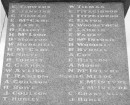SPRING CREEK SAWMILL AND SEASONING WORKS, MOUNT SAMARIA
MOUNT SAMARIA STATE PARK BRIDGE CREEK AND MOUNT SAMARIA STATE PARK BRIDGE CREEK, BENALLA RURAL CITY, MANSFIELD SHIRE
-
Add to tour
You must log in to do that.
-
Share
-
Shortlist place
You must log in to do that.
- Download report
Statement of Significance
What is significant?
The Spring Creek sawmill and seasoning works consists of substantial mill foundations, concrete seasoning kilns, outlet tramway and lowering gear foundations. The site was worked by D J McClelland from 1923-1926, to exploite the messmate and peppermint forests of Mount Samaria. The sawmill itself is represented by substantial timber uprights, foundation logs, sawdust trench and a low sawdust heap. An outlet tramway extends from the mill to the edge of the plateau, where a substantial three-railed incline controlled the lowering of log trucks down to Spring Creek. The braking machinery at the top of the incline was set in massive reinforced concrete foundations. Both the timber tramline and machinery foundations are exceptionally well preserved, with the tramline represented by remnants of wooden rails, packing, culverts, bridges, and loading ramps. The discovery of the eucalypt hardwood seasoning process at Warburton in 1919 prompted the installation of a reconditioning kiln and two drying kilns at the mill site in 1924, to meet the demand for kiln dried flooring timber in metropolitan Melbourne. Although lacking doors and the rail system for positioning timber, the kilns are in excellent condition.
How is it significant?
The Spring Creek sawmill and seasoning works are of historical and scientific significance to the State of Victoria.
Why is it significant?
The Spring Creek sawmill and seasoning works are scientifically significant as a remarkably intact example of an integrated timber production operation. The seasoning kilns demonstrate the timber reconditioning process in its most readily understood form. The tramway systems are very well constructed, and the lowering gear foundations at the top of the incline are probably the best engineered of their type ever constructed in Victoria.
The Spring Creek sawmill and seasoning works are historically significant as the oldest extant demonstration of the kiln drying and reconditioning process in Victoria, a process which transformed the production of seasoned eucalypt hardwoods, and one which remains the first and most essential value-adding process in the Australian timber industry.
[Source: Victorian Heritage Register]
-
-
SPRING CREEK SAWMILL AND SEASONING WORKS, MOUNT SAMARIA - History
Heritage Inventory History of Site: The mill was transferred from its original position on Spring Creek up to the Mount Samaria plateau in 1923. Seasoning kilns were constructed in 1924 to meet the growing demand for kiln-dried flooring timber. Around thirty men worked at the mill, which featured a seven-room boarding house, six houses for married workers and the school teacher, and 18 huts for the single men. Overcapitalisation and poor quality forest forced the closure of the mill in 1926.
SPRING CREEK SAWMILL AND SEASONING WORKS, MOUNT SAMARIA - Interpretation of Site
Heritage Inventory Interpretation: The site demonstrates an important aspect of the timber production process, including sawmilling, seasoning & transport. Timber cut at the mill was air dried, then steam reconditioned for 8-12 hours, before being placed in the drying kilns for around 2 weeks. The timber was then transported along the outlet tramway to the edge of the plateau, lowered down the three-railed incline, and then transferred by road to the railway station at Tatong.
Heritage Inventory Description
SPRING CREEK SAWMILL AND SEASONING WORKS, MOUNT SAMARIA - Heritage Inventory Description
Sawmill foundations, sawdust trench, sawdust heap. concrete seasoning kilns, outlet tramway, concrete incline foundations. The tramline and the machinery foundations are exceptionally well preserved, with the tramline being represented by remnants of wooden rails, packing, culverts, bridges and loading ramps. The kilns are in excellent condition, despite lacking doors and a rail system for positioning the timber. The mill itself is marked by substantial timber uprights, foundation logs, sawdust trench and a low sawdust heap.
Heritage Inventory Significance: The site represents the oldest extant demonstration of kiln drying and reconditioning process in Victoria. The sawmill, tramway and incline foundations are significant as unusually intact examples of timber production and transport. The tramway systems are very well constructed
Recorded by: Peter Davies Date Recorded:?/nHeritage Inventory Site Features: Sawmill foundations , sawdust trench, saw dust heap, concrete seasoning kilns, outlet tramway, concrete incline foundations. The site extends in a 100 metre radius around the mill shed site and for 20 metre either side of surviving tramway formations. site features include: low sawdust heap. 3 concrete kilns, concrete boiler settings, sawdust trench and extensive foundation timbers of the mill shed. The outlet tramway features sections of dry-stone walling, wooden rails, packing, culverts, bridges, loading ramps, & massive concrete incline foundations. There may also be extensive surface & sub-surface remains relating to settlement at the sawmill site.
Archeological Potential: Remnant Structure,Site
-
-
-
-
-
SPRING CREEK SAWMILL AND SEASONING WORKS
 Victorian Heritage Register H1824
Victorian Heritage Register H1824 -
SPRING CREEK SAWMILL AND SEASONING WORKS, MOUNT SAMARIA
 Victorian Heritage Inventory
Victorian Heritage Inventory
-
-







